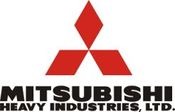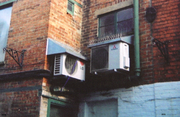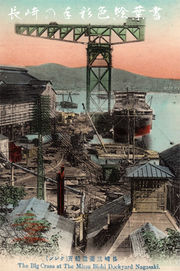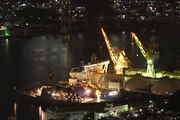Mitsubishi Heavy Industries
 |
|
| Type | Public KK (TYO: 7011) |
|---|---|
| Founded | 1934, 1964 |
| Headquarters | 16-5, Kounan 2-chome, Minato, Tokyo 108-8125 Japan |
| Area served | Global |
| Key people | Kazuo Tsukuda (Chairman) Hideaki Omiya (President) Hideo Egawa (VP) Ichiro Fukue(VP) |
| Revenue | |
| Net income | |
| Employees | 63,500 |
| Divisions | Marine Vessel and Ocean Power Engine Machinery and Iron Structure Aviation and Space Medium-size Product The Others |
| Website | mhi.co.jp |
Mitsubishi Heavy Industries, Ltd (三菱重工業株式会社 Mitsubishi Jūkōgyō Kabushiki-kaisha), or MHI, is a Japanese company. It is one of the core companies of Mitsubishi Group.
Contents |
History
In 1870 Yataro Iwasaki, the founder of Mitsubishi took a lease of Government-owned Nagasaki Shipyard. He named it Nagasaki Shipyard & Machinery Works, and started the shipbuilding business on a full scale. This shipbuilding business evolved into Mitsubishi Shipbuilding Co., Ltd., which became Mitsubishi Heavy Industries, Ltd. in 1934. It was the largest private firm in Japan, manufacturing ships, heavy machinery, airplanes, and railroad cars.
Following the end of World War II, and the dissolution of the zaibatsu MHI was divided into three entities: West Japan Heavy-Industries, Ltd., Central Japan Heavy-Industries, Ltd. and East Japan Heavy-Industries, Ltd. It was re-consolidated in 1964 and reborn as Mitsubishi Heavy Industries, Ltd.
In 1970, MHI's automobile department became independent and Mitsubishi Motors began manufacturing and marketing automobiles.
Product lines and businesses

- Aerospace Systems.
- Facilities Nagoya Aerospace Systems, Aichi, Nagoya Guidance & Propulsion Systems, Aichi, Mitsubishi Aircraft Corporation.
- Shipbuilding / Marine structures.
- Steel structures and construction.
- Power systems and traction batteries.
- Facilities Takasago, Kobe.[1]
- Turbochargers.
- Machinery.
- Forklifts - Mitsubishi Forklift Trucks
- Military Combat Tanks.
- Facilities Sagamihara.
- Prime contractor for the H-IIA launcher system.
- General machinery.
- Wind turbines.[2]
- Air conditioning and refrigeration systems
- Industrial machinery.
- Paper and printing machinery.
- Machine tool.
- Light rail vehicles.
Aerospace systems
As the leading company of the Japan's aerospace industry, Mitsubishi Heavy Industries (MHI) has been engaged in the development and production of a wide variety of aerospace products and thus contributed to the advancement of Japan, a technology-oriented nation, through its cutting-edge technologies.
In the defense sector, MHI has consistently produced jet fighters for Japan Air Self-Defense Force and anti-submarine helicopters for Japan Maritime Self-Defense Force, as well as various other products, such as aero-engines, missiles and torpedoes. The company also plays an important role in the Ballistic Missile Defense System program. In addition, MHI is preparing itself to respond to the needs of the joint operation capabilities.
In the civil aircraft sector, MHI takes charge of the development and manufacture of major airframe components, including fuselage panels for Boeing 777 and composite-material wing boxes for the 787. In the space systems sector, MHI is the producer of the H-IIA and H-IIB launch vehicles, Japan's main rockets, and provides launch services to JAXA for them. The company is also involved in the International Space Station program.
On April 1, 2008, MHI established subsidiary Mitsubishi Aircraft Corporation to develop and produce the MRJ or Mitsubishi Regional Jet, a 70 to 90 passenger regional airliner. MHI is the plurality shareholder of the new company, with Toyota Motor Corporation owning 10%.[3]
Nuclear energy systems
The nuclear business of MHI operates facilities Kobe, Yokohama, Kanagawa,Takasago, Hyogo. It also operates a nuclear fuel manufacturing plant in Tōkai, Ibaraki which processes 440 Metric tons of Uranium per year.
MHI has also developed the Mitsubishi APWR, which, as of July 2007, has been selected for use in two sites in Japan and the United States. MHI has also signed a memorandum of understanding with Areva for the establishment of a joint venture for their next reactor design.[4]
MHI has also been selected as the core company to develop a new generation of Fast Breeder Reactors (FBR) by the Japanese government.[5] After that announcement was made, MHI established a new company, Mitsubishi FBR Systems, Inc. (MFBR) specifically for the development and realization for FBR technology, starting what is likely to be the most aggressive corporate venture into FBR and Generation IV reactor technology.[6]
Clients
- Boeing
- MTR
- SBS Transit
- Singapore Changi Airport
- Washington Dulles International Airport
- Milwaukee Brewers/Miller Park retractable roof
- Rolls-Royce
- PKN Orlen
Shipbuilding

Mitsubishi Heavy Industries - Nagasaki Shipyard & Machinery Works (三菱重工長崎造船所 Mitsubishi Juko Nagasaki Zosenjo) is the primary shipbuilding division Mitsubishi Heavy Industries. It produces primarily specialized commercial vessels, including LNG carriers, oil tankers, and passenger cruise ships. In addition, it is also a producer of a wide variety of machinery for power plants, energy production and aerospace use.
History
In 1857, at the request of the Tokugawa Shogunate, a group of Dutch engineers began work on the Nagasaki Yotetsusho, a modern, western-style foundry and shipyard near the Dutch settlement of Dejima, at Nagasaki. Renamed Nagasaki Seitetsusho in 1860, it was completed in 1861. Following the Meiji restoration of 1868, the shipyard was placed under control of the new Meiji government, and the first dry dock was completed in 1879.
In 1884 Yataro Iwasaki, the founder of Mitsubishi, leased the Nagasaki Seitetsusho from the government and re-named it the Nagasaki Shipyard & Machinery Works, and started the shipbuilding business on a full scale. He purchased the shipyards outright in 1887. The works was renamed Mitsubishi Shipyard of Mitsubishi Goshi Kaisha in 1893 and additional dry docks were completed by 1896 and 1905.
The company was renamed Mitsubishi Shipbuilding & Engineering Company, Ltd. in 1917 and again renamed as Mitsubishi Heavy Industries in 1934. It became the largest private firm in Japan, manufacturing ships, heavy machinery, airplanes, and railroad cars.
From its inception, the Mitsubishi Nagasaki shipyards were heavily involved in contracts for the Imperial Japanese Navy. The battleship Musashi was completed at Nagasaki in 1942.
Following the dissolution of the zaibatsu after the surrender of Japan at the end of World War II, Mitsubishi Nagasaki came under the aegis of West Japan Heavy-Industries, Ltd., and was again renamed Mitsubishi Shipbuilding & Engineering Co., Ltd. in 1952.
However, in 1964, the three independent companies of Mitsubishi Heavy Industries, decentralized in 1950, were merged again into one company under the name of Mitsubishi Heavy Industries, Ltd., and the works was renamed the Nagasaki Shipyard & Engine Works.
Products

- Boilers for fossil fuel power plants
- Steam turbines
- Wind Turbines
- Diesel Engines
- Fuel cells
- Oil Tankers
- LPG Carriers
- Cruise ships
- Rockets and spacecraft
- Torpedoes
- Desalination Equipment
- Air Conditioners
- Warships
- Hatakaze class destroyer
- Harushio class submarine
- Atago class destroyer
- Takanami class destroyer
- Tachikaze class destroyer
- Sōryū class submarine
- Oyashio class submarine
- Kongō class destroyer
Electric buses
Mitsubishi Heavy Industries is developing all-electric buses capable of battery swapping.
See also
- Mitsubishi
- Mitsubishi Dynaboars - rugby team
- Urawa Red Diamonds - football (soccer) team, became part of Mitsubishi Motors in 1970
- Nickel metal hydride battery
- Sanyo
- Mitsubishi ATD-X- Stealth Plane
- Mitsubishi Regional Jet
- List of Mitsubishi aircraft
Notes
- ↑ "Mitsubishi Heavy to make lithium ion car batteries", Reuters, 23 January 2007, as found at Yahoo! Singapore Finance website
- ↑ Wind Turbine Generators | Mitsubishi Heavy Industries, Ltd
- ↑ Toyota to sink $67.2 mln in Mitsubishi passenger jet, China Economic Net, May 23, 2008
- ↑ AREVA and MHI Sign Memorandum of Understanding on the Establishment of a Joint Venture for Their New Reactor
- ↑ Nuclear power in Japan
- ↑ MHI Establishes New Company for FBR Development
References
- Chida, Momohei and Peter N. Davies. (1990). The Japanese Shipping and Shipbuilding Industries: A History of their Modern Growth. London: Athlone Press. 10-ISBN 0-485-11271-X; 13-ISBN 978-0-485-11271-9; OCLC 20799046
- Kizu, Shigetoshi. (1984). A 100 Years' History of the Ships of Nippon Yusen Kaisha. Tokyo: NYK. 10-ISBN 4-905551-20-X; 13-ISBN 978-4-905551-20-1; OCLC 16781302
- Ponsonby-Fane, Richard Arthur Brabazon. (1935). The Nomeclature of the N.Y.K. Fleet. Tokyo: NYK. OCLC 27933596
- Wray, William D. (1984). Mitsubishi and the N.Y.K., 1870-1914: Business Strategy in the Japanese Shipping Industry. Cambridge: Council on East Asian Studies, Harvard University, Harvard University Press. 10-ISBN 0-674-57665-9; 13-ISBN 978-0-674-57665-0; OCLC 10825248
External links
- Company website (in Japanese)
- Company website (in English)
- WW2DB: Mitsubishi Military Aircraft of World War II
|
||||||||
|
||||||||||||||||||||||||||||||||||||||||||||||||||||||||||||||||||